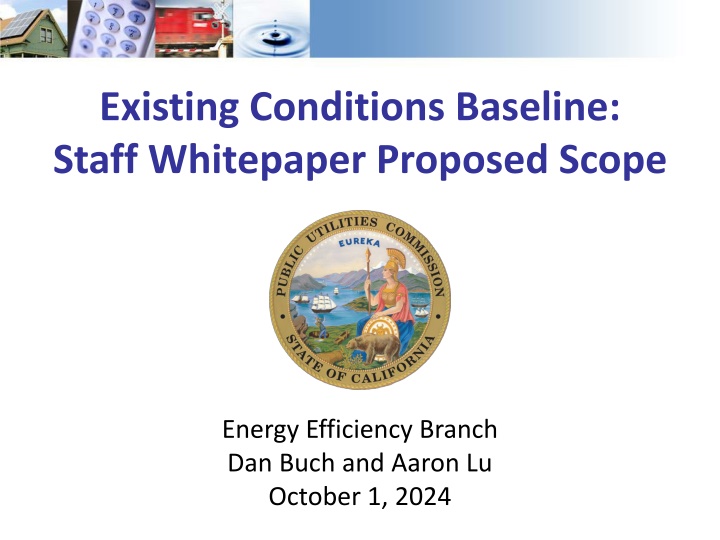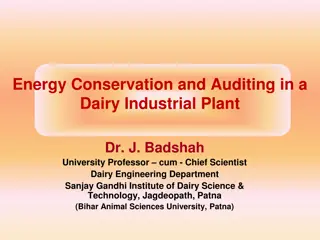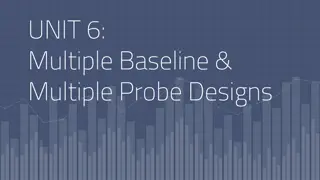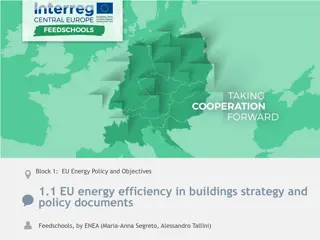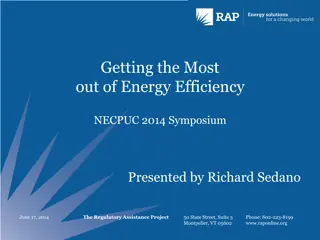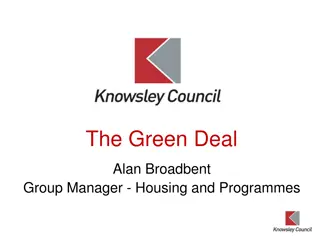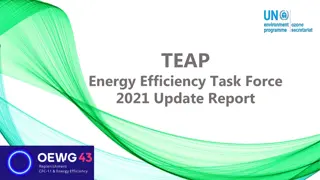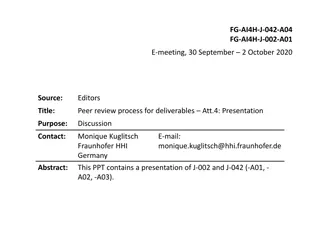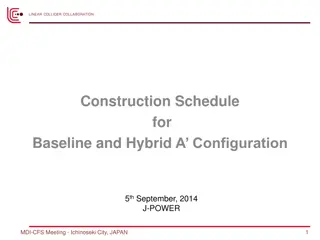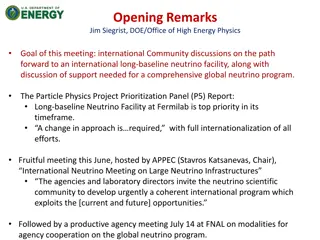Energy Efficiency Whitepaper: Baseline Analysis and Policy Recommendations
The whitepaper discusses the existing baseline policy and treatments related to energy efficiency in facilities. It identifies challenges in motivating customers to adopt energy-saving measures and proposes objectives to clarify policy, develop analytical frameworks, and enhance stakeholder engagement in decision-making processes.
Download Presentation

Please find below an Image/Link to download the presentation.
The content on the website is provided AS IS for your information and personal use only. It may not be sold, licensed, or shared on other websites without obtaining consent from the author.If you encounter any issues during the download, it is possible that the publisher has removed the file from their server.
You are allowed to download the files provided on this website for personal or commercial use, subject to the condition that they are used lawfully. All files are the property of their respective owners.
The content on the website is provided AS IS for your information and personal use only. It may not be sold, licensed, or shared on other websites without obtaining consent from the author.
E N D
Presentation Transcript
Existing Conditions Baseline: Staff Whitepaper Proposed Scope Energy Efficiency Branch Dan Buch and Aaron Lu October 1, 2024 1
Scope of Baseline Analysis Articulate the current baseline policy and characterize the current baseline treatments (staff whitepaper) Identify policy questions that may require additional analysis and evidence (staff whitepaper) Identify and characterize measure categories by the baseline treatment(s) that should be applied (staff whitepaper) Collect evidence from best available sources regarding unrealized opportunities for efficiency savings below code/ISP baselines (staff/stakeholder comments/IOU pilots) Compile, categorize, and analyze these opportunities for each measure category and baseline treatment (staff/Navigant) 1. 2. 3. 4. 5. 2
Outline Problem Statement Objectives Defining Types of Measures & Baseline Treatments Equipment Baselines Retrofit Add On Baselines Retrofit Baselines Custom Industry Standard Practice Baselines Appendices 3
Problem Statement The challenges that the parties describe can be characterized as the following: Many existing facilities particularly older ones contain opportunities for greater energy efficiency but may not be upgrading frequently. Current Commission-approved incentives based on code/industry standard practice baselines may be insufficient to motivate customers to adopt these measures. The increasing stringency of new codes may further exacerbate the above and may leave little above-code savings that could justify sufficient incentive levels to induce customers to upgrade existing facilities. 4
Objectives Workshop Explain current Commission policy for baselines Develop scopes for in-depth policy analysis Identify areas of potential concern to stakeholders Present draft measure category classification list Whitepaper Clarify and consolidate current Commission policy for baselines in a single, accessible document Develop an analytical framework that will assist staff and stakeholders in evaluating the potential impacts of alternative baseline policies Identify possible or needed sources of evidence to inform the record for decision-making purposes 5
Defining Types of Measures & Baseline Treatments Deemed Equipment Retrofit Add-On Retrofit Custom Industry Standard Practice 6
Key Terms Effective Useful Life (EUL): an estimate of the median number of years that a measure stays in place and is still operational Remaining Useful Life (RUL): an estimate of the median number of years a technology or piece of equipment would remain in service and operational had the program intervention not caused the replacement or alteration; default Commission policy assumes that RUL is equal to one- third of the EUL Industry Standard Practice (ISP) Heating, Ventilation, and Air Conditioning (HVAC) Seasonal Energy Efficiency Ratio (SEER) 7
Equipment Baselines New construction: the equipment is being installed in a new building or a to studs major renovation such that it is not replacing other functioning equipment Replace on burnout: the new equipment is replacing installed equipment that is no longer functional or beyond its useful life Early retirement: the new equipment is replacing installed equipment that is still functioning and has remaining useful life; must be program induced. 8
Equipment Current Policy Replace on Burnout Early Retirement 1/3 EUL (RUL) 2/3 EUL EUL 1/3 EUL (RUL) 2/3 EUL EUL Above Code Savings Above Code Savings Code Code Existing Conditions Existing Conditions 9
Equipment Measure Category Examples Appliances Lamps (lighting) Hot Water Heaters Smart Strips Cooking Equipment Office Equipment 10
Scope of Analysis: Assessment of Equipment Early Retirement Policy Review: the current baseline for early retirement measures the current EUL/RUL rules used for early retirement measures the current evidentiary standards for early retirement measures how measure costs are applied for early retirement savings claims and cost effectiveness reporting current early retirement program delivery strategies (third party programs and direct install programs) Analyze: the potential impacts of alternative baseline treatments the potential impacts of potential rule modifications the potential impacts of alternative evidentiary standards the potential impacts of alternative measure cost applications Discuss potential alternative delivery strategies and analyze the policy modifications they might necessitate. 11
Retrofit Add-On Baselines New equipment has been installed onto an existing system, either as an additional, integrated component or to replace a component of the existing system. In either case, the primary purpose of the add-on measure is to improve overall efficiency of the system. Since the retrofit add-on is not stand alone, the EUL of a retrofit add-on measure is capped at the RUL of the equipment being retrofitted. This means that retrofit add-on measures utilize the EUL of the retrofit add-on measure up to and not to exceed the RUL for the existing equipment. 12
Retrofit Add-On Current Policy Retrofit Add On Existing System 1/3 EUL existing (RUL existing) 2/3 EUL existing EUL existing Add-On Retrofit Equipment RUL existing EUL add-on 13
Retrofit Add-On Measure Examples Window Films HVAC Controls Boiler Controls Commercial Refrigeration Add-ons Energy Management Systems 14
Scope of Analysis: Retrofit Add on Review: the current definition of retrofit add-on and the appropriate measures that are applicable the current baseline for retrofit add-on measures the current EUL/RUL rules used for retrofit add-on measures the current evidentiary standards for retrofit add-on measures Analyze: the potential impacts of alternative baseline treatments the potential impacts of potential rule modifications the potential impacts of alternative evidentiary standards 15
Retrofit Baselines Retrofit category measures are currently not subject to a uniform set of rules. What distinguishes these measures from other measures is that, in most cases, the measures will be replaced not due to equipment failure but rather triggered by building renovation and program- and code- induced actions. 16
Retrofit Current Policy These measures have a variety of baselines in the current paradigm, including current code baseline, vintage code baseline, and existing conditions baseline. A threshold question is whether this classes of measures needs a new framework for assessing savings. Alternatively, it may be the case that modifications to current methodologies for parameter calculations (e.g. EUL/RUL) will be sufficient and that a creating a new category is unnecessary. 17
Retrofit Measure Examples Insulation Ventilation Duct Sealing/Repair Fixtures/Ballasts Water Distribution (Pipe Insulation) Water Fixture Replacements 18
Scope of Analysis: Retrofit Review: potential definitions of measures to be included in this category Threshold question: do retrofit measures need a standardized baseline framework or is the current classification scheme sufficient? the current baselines for retrofit measures Analyze: the potential impacts for classifications in the measure category list the potential impacts of this determination how alternative baseline treatments for these measures could impact portfolios the potential impacts of potential rule modifications the potential impacts of alternative evidentiary standards the current EUL/RUL rules used for retrofit measures the current evidentiary standards for retrofit measures 19
Custom ISP Baselines ISP studies are used to determine the appropriate baseline for technologies (measures or processes) for which a code or standard (such as ASHRAE) does not exist. ISP may also apply when the commonly purchased technology exceeds existing codes or standards. The technology or efficiency level that is determined to be typically purchased in a specific market segment sets the baseline for installation of that measure in a project. 20
Custom ISP Current Policy ISP is not based on a determination of installed technologies but rather looks to recent market activity in a specific segment. 21
Custom ISP Examples Oil Pipeline Pump VFD Outdoor Steam Pipe Insulation Refrigerated Juice Tank Insulation Wastewater Aerator Blower VFD Heat Recovery for Almond Drying 22
Scope of Analysis: Custom ISPs Review: Threshold question: is ISP an appropriate topic for review along with code baselines or should it be reviewed in another venue? the current ISP rules used for technologies and/or projects without code baselines Discuss the applicability of ISP to measures with code or standard baselines where standard market practice is above current code the current evidentiary standards for ISP studies Analyze: the potential impacts of potential rule modifications the potential impacts of alternative applications of ISP to above code measures the potential impacts of alternative evidentiary standards 23
Appendices Deemed Measure Category Classification List Residential Sectors Commercial Sectors Industrial and Agricultural Sectors Baseline Treatment Examples 24
Deemed Measure Category List (RES) Residential Sector Measure Category Classification Building Envelope Insulation Window Film Plug Loads & Appliances Dishwasher Laundry Refrigeration PC/Monitors Smart Strips HVAC Space Heating Space Cooling Ventilation Duct Sealing/Repair Controls HVAC Quality Maintenance Retrofit Retrofit Add On Equipment Equipment Equipment Equipment Equipment Equipment Equipment Retrofit Retrofit Retrofit Add On Retrofit Add On 25
Deemed Measure Category List (RES) Indoor/Outdoor Lighting Lamps Equipment Fixtures/Ballast Retrofit Controls Retrofit Recreation Pool Pumps Equipment Service Hot Water Water Heaters/ Boilers Equipment Water Fixture Replacements Retrofit Recirculation Pumps Equipment/Retrofit Add On Boiler Controls Retrofit Add On 26
Deemed Measure Category List (COM) Measure Category Classification Commercial Sector Building Envelope Insulation Retrofit Window Film Retrofit Add On Plug Loads & Appliances Office Equipment Equipment Vending Machine Controller Retrofit Add On Commercial Refrigeration Casework, Compressors, Condensers, etc. Equipment Add On Controllers, VSDs, Doors, ASH, etc. Retrofit Add On Food Service Equipment Cooking Equipment Equipment 27
Deemed Measure Category List (COM) HVAC Space Heating Space Cooling Chiller Ventilation Duct Sealing/Repair Controls Energy Management Systems Indoor/Outdoor Lighting Lamps Fixtures/Ballast Controls (occupancy, daylight, etc.) Parking Garage Lighting Process Heat/Refrigeration Variable Frequency Drive Equipment Equipment Equipment Retrofit Retrofit Retrofit Add On Retrofit Add On Equipment Retrofit Retrofit Equipment Retrofit Add On 28
Deemed Measure Category List (COM) Recreation Pool Pumps Pool Heaters Pool Covers Service HVAC Quality Maintenance Retro-commissioning Service Hot Water Water Heating/Boilers Water Fixture Replacements Recirculation Pumps Distribution (Insulation) Boiler Controls Equipment Equipment Equipment/ Retrofit Add On Retrofit Add On Retrofit Add On Equipment Retrofit Equipment/ Retrofit Add On Retrofit Retrofit Add On 29
Deemed Measure Category List (IN/AG) Measure Category Classification Industrial and Agricultural Sectors Building Envelope Insulation Retrofit Process Heating Boilers Equipment Boiler Controls, Economizers, etc. Retrofit Add On Process Equipment Process Capacity Expansion (Added Machines, etc.) Equipment Process Controls, Motor/Drive Components, etc. Retrofit Add On Industrial/Agricultural Refrigeration Chillers, Compressors, Condensers, Cooling Towers, etc. Add On Controllers, VSDs, Sub-coolers, etc. Equipment Retrofit Add On 30
New Equipment Examples Installation of a high-efficiency split system central air conditioner New Construction, major renovation or added cooling capacity: Single baseline calculation. Incremental savings and cost above code-level SEER 14 (code as of 1/1/2015), with the cost not to be less than the incentive or direct install program cost. Replace on Burnout: Single baseline calculation. Incremental savings and cost above code-level SEER 14 (code as of 1/1/2015), with the cost not to be less than the incentive or direct install program cost. Program Induced Early Retirement: Dual baseline calculation. Savings over pre-existing equipment for the RUL of the equipment being replaced, then savings above code-level SEER 14 (code as of 1/1/2015) for the rest of the EUL. Cost is full installed cost minus the net-present-value (discounted) full installed cost of the code-level SEER 14 unit, with the cost not to be less than the incentive or direct install program cost. 31
Retrofit Add-On Example Installation of a boiler control (EUL of 20 years) on a 10-year old standard condensing boiler (EUL of 20 years, RUL of 6-2/3 years) Retrofit Add-On: Single baseline calculation from existing conditions. Full savings from pre-existing equipment in as rated operating condition. EUL of boiler control capped at RUL of underlying boiler of 6-2/3 years. 32
Retrofit Examples Water fixtures Showerheads - New equipment, Normal Replacement: Single baseline calculation using code baseline, incremental savings and cost, full EUL of the measure, with the cost not to be less than the incentive, material or direct install program costs paid by the program. Aerators - Retrofit Add-On: Single baseline calculation using existing equipment in as rated operating condition, full savings and cost, full EUL of the measure capped by the RUL of the pre-existing of 3-1/3. Insulation of additional R-value as an add-on for an existing house Retrofit Add-On: Single baseline calculation using existing insulation in as rated condition, full savings and cost, full EUL of the measure capped by the RUL of the pre-existing of 6-2/3. 33
Custom ISP Examples Outdoor Steam Pipe Insulation Interviews indicated insulation is the commonly used design practice Most common cited insulating material was mineral wool with an aluminum jacket; ISP is to install a minimum of 2 inches of insulation Projects proposing insulation thickness in excess of 2 inches should qualify for incentives 34
